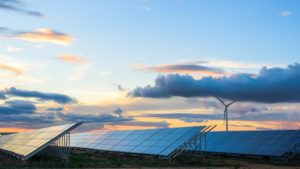As the clean energy industry enters 2019, it can be tempting to get discouraged by the dire climate news that came out toward the end of the year. Global carbon emissions are headed in the wrong direction, which is particularly disappointing for those of us who have been working to reverse this trend. Add to that the continuous rollback of key environmental regulations long accepted as necessary to reduce air pollution and greenhouse gases, and the urge to take a long winter’s nap can be overwhelming.
 But there is good news to rouse our spirits. While official US policy still favors exiting the Paris Climate Agreement, a groundswell movement is underway. Cities, states and businesses are not waiting for the federal government to act to address climate change. “We Are Still In” is a coalition of 3,600 states, cities, colleges, businesses and nonprofits all committed to the Paris accord – and putting up real money to activate a new line of defense against the creeping assault on our health and well-being.
But there is good news to rouse our spirits. While official US policy still favors exiting the Paris Climate Agreement, a groundswell movement is underway. Cities, states and businesses are not waiting for the federal government to act to address climate change. “We Are Still In” is a coalition of 3,600 states, cities, colleges, businesses and nonprofits all committed to the Paris accord – and putting up real money to activate a new line of defense against the creeping assault on our health and well-being.
Action is the key word here. And it’s not just action by those you’d expect – industry insiders, environmentalists, or those “know-it-all” scientists – it’s action from the least likely of places. The Fortune 500 are making unprecedented commitments to renewable energy, as this article from Utility Dive states:
Last year, U.S. companies signed contracts for more than 6,400 megawatts of renewable energy, an all-time record and more than double the amount companies purchased the year before. Once dominated by Silicon Valley tech companies (including Facebook, whose 22 deals in 2018 accounted for more clean power than all corporate buyers combined in 2016), last year’s list of corporate renewable energy buyers represented a growing diversity of industries and geographies.
New buyers of clean energy include conventional energy stalwarts, telecom giants and even some coal-country companies.
Exxon Mobil, who committed to purchase 500MW of wind and solar to power oil extraction in Texas’ Permian Basin, stirred up a flurry of headlines. Lowes, Kohls, AT&T and T-Mobile all became significant buyers of renewable energy. Kentucky whiskey producer Brown Forman sidled up to the bar as the first major U.S. spirits and wine producer to enter into a power purchase agreement for renewable energy.
These companies are taking action because they recognize an economic reality: Clean energy is simply better for the bottom line than fossil-fuel electricity. Again, quoting Utility Dive:
According to financial advisory and asset management company Lazard’s “Levelized Cost of Energy and Levelized Cost of Storage 2018” analysis, utility-scale wind has dropped in cost by 69% over the last 9 years, and utility-scale solar has dropped by 88% in that same time period. As a result, the cost of electricity from both wind and solar is now “at or below the marginal cost of conventional generation.” Put more simply, clean energy is now cheaper than the dirty stuff.
When you factor in the added brand value of going renewable – that intangible “it” factor that is so hard to measure – the value of powering corporate operations sustainably is even higher.
Clean energy is just one piece of a company’s overall sustainability strategy, which together can be a powerful way to get customers to sit up and take notice.
How can your organization make a sustainable difference?
Any company, city, state, university, nonprofit, faith group, tribe or cultural entity can join the “We Are Still In” coalition for free. Those interested in tracking their efforts in alignment with the goals of the Paris Agreement can set science-based targets through the Science-Based Targets Initiative web site. SBTI publishes a step-by-step guide on how to develop and commit to more substantive goals, including strategies and case studies on how companies are increasing their competitive edge through sustainability strategies.
In the coming months, we’ll highlight some of the organizations making new commitments to sustainability and clean energy. We’ll provide a roadmap for sustainable change for those who want to forge ahead in this bold new business reality. And we’ll answer all your questions on what the true impact of your sustainability efforts could be.
If your company is involved in the clean energy sector, having a sustainability strategy in place is even more important. But sometimes the cobbler’s children have no shoes. So how can your organization take the first step? Right now, the answer is simple: Join our email list. We’ll be in touch with best practices and ideas to help you build meaningful sustainability strategies that help you “walk the walk” and drive true change in your company, your community, and your world.
Have ideas, questions or comments? Please post below or always feel free to email us at info@cleanpowermarketing.com
Stay tuned, and Happy New Year!



